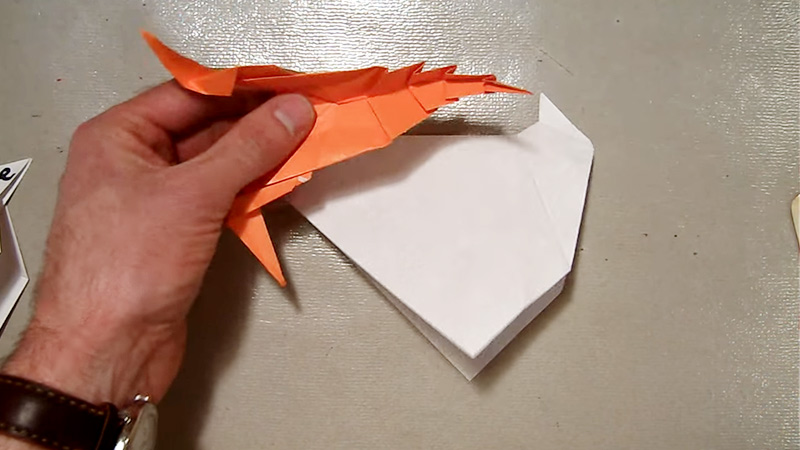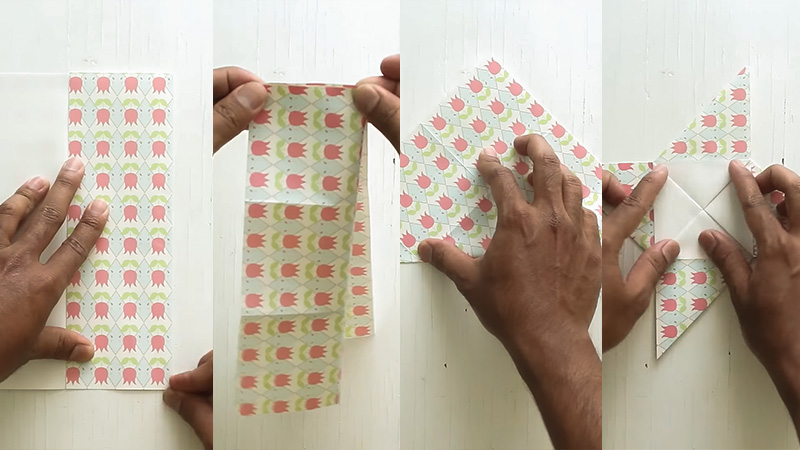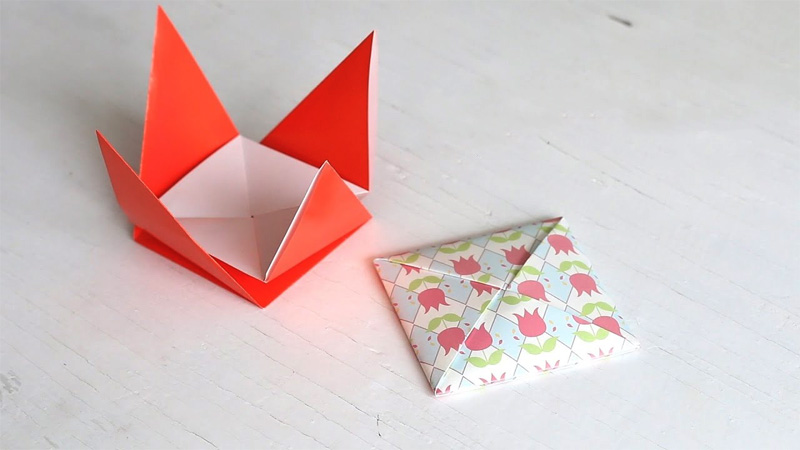Origami, the ancient Japanese art of paper folding, is a captivating world of creativity and precision.
Within this intricate craft, the pivot fold stands as a fundamental technique that elevates simple sheets of paper into intricate three-dimensional sculptures.
A pivot fold is a transformative maneuver, allowing origami artists to pivot or rotate a paper flap around a specific point, thereby creating new angles and dimensions within their creations.
This technique introduces a dynamic aspect to traditional origami models, enabling the folding enthusiast to craft a diverse range of objects, from animals to architectural wonders.
The pivot fold embodies the essence of origami’s endless possibilities, merging mathematics, design, and artistry to fashion captivating paper marvels.

What Is a Pivot Fold in Origami?
A pivot fold in origami is a fundamental folding technique that allows paper to be rotated or pivoted around a specific point, creating a hinge-like effect.
This maneuver is pivotal (pun intended) in achieving more complex and three-dimensional origami models.
To execute a pivot fold, you start with a folded or partially folded piece of paper, typically at a corner or edge.
You then select a point where you want the paper to pivot, often marked with a small dot or crease.
With precision and careful attention to the chosen pivot point, you fold the paper, allowing it to rotate around that spot. This rotation can be 90 degrees, 180 degrees, or any other angle necessary for the design.
Pivot folds are crucial for various origami models, as they enable the creation of limbs, wings, flaps, and other movable parts.
These folds add dynamism and depth to origami creations, making them more lifelike and intricate.
Origami artists use pivot folds to craft a wide range of objects, from animals and insects with movable appendages to architectural structures with doors and windows.
In essence, a pivot fold is like a hinge that breathes life into a flat sheet of paper, allowing it to transform into complex and engaging origami sculptures.
It embodies the essence of origami, which combines mathematical precision with artistic creativity to transform a simple piece of paper into a work of art.
Types of Folds in Origami

Origami, the art of paper folding, involves a wide variety of folds that serve as the building blocks for creating intricate and beautiful paper sculptures.
Here are some of the most common types of folds in origami:
Valley Fold
A valley fold is one of the foundational folds in origami. To perform a valley fold, you start with a crease line or guideline on the paper.
Then, you fold the paper towards you along this line, which creates a “V” shape or valley with the folded edge facing upward.
Valley folds are often used to make booklets, accordion folds, and other basic shapes. They serve as a simple way to manipulate the paper’s surface and introduce three-dimensionality into the model.
Mountain Fold
In contrast to a valley fold, a mountain fold involves folding the paper away from you along a designated crease line.
This results in a raised “ridge” or peak, with the folded edge on the underside of the paper.
Mountain folds are frequently used to create sharp, pointed features in origami, such as animal noses, wings, or angular sections of geometric shapes. They add depth and structure to the model.
Square Fold
The square fold is a basic fold used to divide a square piece of paper into two equal halves, forming a right angle at the corner.
This fold serves as a starting point for many origami models, as it provides a foundational structure that can be further manipulated and folded to create various shapes and designs.
Outside Reverse Fold
The outside reverse fold is a technique used to expose the hidden side of a flap of paper. To achieve this fold, you first create a valley fold, and then you fold the flap back outwards, reversing the original fold.
This fold is particularly useful for creating limbs, tails, and other protruding elements in origami models, allowing for greater detail and realism.
Inside Reverse Fold
The inside reverse fold is essentially the reverse of the outside reverse fold. It involves concealing a flap of paper within the model, hiding it from view.
This fold is employed to create tucked-in features, like the underside of an animal’s paw or the hidden part of a model’s clothing.
It adds intricacy and a sense of completeness to the final design by concealing excess paper.
Pleat Fold
The pleat fold is characterized by a series of parallel mountain and valley folds that create a zigzag or accordion-like pattern.
It is often used to add texture and depth to origami models, especially for creating structures like fans, curtains, or detailed clothing in figurative origami models. The pleat fold allows for intricate layering and realistic detailing in origami designs.
Sink Fold
A sink fold is employed to transform a flat sheet of paper into a three-dimensional form by “sinking” a portion of the paper inward.
This technique is particularly useful for creating complex origami models like animals, where various layers of paper are folded inward to shape the body or limbs. Sink folds require precision and skill to achieve the desired shape and volume in the final model.
Petal Fold
The petal fold is a technique used to divide a square piece of paper into smaller squares or rectangular sections, creating a flower-like shape.
This fold is commonly used in floral origami to craft petals, leaves, and other botanical elements. It’s a fundamental step in creating origami flowers that closely resemble their real-life counterparts.
Blintz Fold
In the blintz fold, a square piece of paper is folded into quarters, resulting in a smaller square with multiple flaps.
This fold is often used as a starting point for various origami models, especially those that involve intricate details or multiple layers.
The blintz fold provides a compact and stable structure to build upon, making it a valuable technique in complex origami designs.
Rabbit Ear Fold
The rabbit ear fold is a technique commonly used to create pointy, triangular shapes in origami.
It involves folding two sides of a square or rectangular piece of paper to meet at the center, resembling the ears of a rabbit.
This fold is versatile and can be adapted for various purposes, such as forming the beak of a bird or the pointed corners of a box.
Waterbomb Base
The waterbomb base is a fundamental origami fold that serves as the starting point for various models, including the classic waterbomb or balloon shape.
To create a waterbomb base, you begin with a square piece of paper and fold it diagonally in both directions to create two intersecting creases. Then, collapse the paper along these creases to form a triangular module.
Squash Fold
The squash fold origami butterfly is a technique that involves opening a flap or section of an origami model and then flattening it against the paper’s surface.
This action results in a squashed, wider shape, often used to create more intricate details or to refine the appearance of a model.
Squash folds are particularly useful for giving volume and dimension to certain parts of origami, such as adding depth to a face or forming the petals of a flower.
Swivel Fold
The swivel fold is a rotational folding technique that allows you to turn a flap or section of the paper in a specific direction.
This fold is particularly useful for creating mobile or articulated origami models, as it enables various parts to pivot or swivel independently.
Swivel folds are employed in designs like movable limbs of animals, rotating propellers, or any element of an origami model that needs to change orientation or direction.
How Many Times Can You Fold a Piece of Paper

You can’t fold a piece of paper more than seven times based on the assumption that you are using a standard sheet of paper and folding it in half each time.
This limitation arises because each fold essentially doubles the paper’s thickness, making it increasingly difficult to fold as you go.
With a typical sheet of paper, it becomes practically impossible to fold it more than about seven or eight times.
However, if you were to use an extremely large sheet of paper or a very thin paper, you could potentially fold it more times.
In fact, there have been experiments where people have folded large sheets of paper many times, but they typically require special equipment or very unusual conditions.
FAQS
What is an origami pocket fold?
An origami pocket fold is a paper-folding technique that creates a small pocket or pouch within a piece of paper, often used for decorative or functional purposes in origami projects.
How is a pivot fold different from other origami folds?
Unlike traditional folds that create flat or linear shapes, a pivot fold introduces movement and dimensionality to the paper by allowing specific sections to rotate or pivot.
What are some common examples of origami models that use pivot folds?
Some common examples of origami models that incorporate pivot folds include butterflies with movable wings, birds with flapping wings, or animals with articulated parts that can be posed.
Are pivot folds challenging for beginners in origami?
Pivot folds can be more complex than basic folds, so they may be a bit challenging for beginners.
Can pivot folds be used for practical purposes in origami?
Yes, pivot folds can be used for both decorative and functional purposes in origami.
Wrap Up
In origami, the pivot fold stands as a captivating technique that brings life and movement to paper creations.
It deviates from traditional flat folds, introducing a dynamic element. This clever maneuver allows specific sections to pivot or rotate, resulting in intricate, three-dimensional designs that captivate the eye.
While pivot folds may present a challenge for beginners, they offer endless opportunities for creativity and innovation in origami artistry.
From flapping wings on birds to articulated components in animals, pivot folds enable origamists to craft intricate models that come to life.
It’s a testament to the limitless possibilities that a simple sheet of paper can hold when guided by skill and imagination.
Leave a Reply